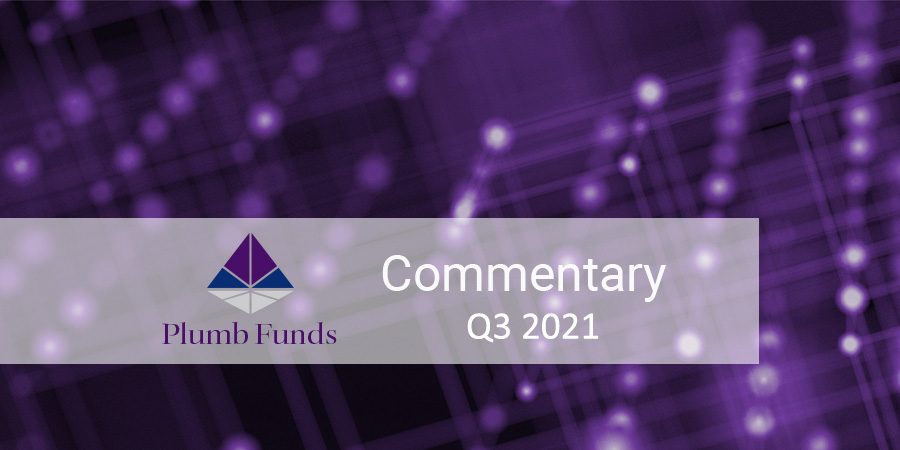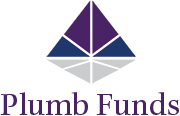
Thomas G. Plumb, CFA
Lead Fund Portfolio Manager
President, CEO, Chairman
The September quarter continued the uneven economic recovery in the United States and much of the world. While government policies have been focused on minimizing the pandemic pain on the most vulnerable segments of our population, the incredible actions of the Federal Reserve Bank (in adding liquidity to the economy) and the State and Federal spending initiatives have had the additional effect of increasing asset prices including the stock, real estate, and commodity markets.
The unprecedented run up in stock prices from market lows last Spring, increasing concern about inflation pressure, significant supply chain bottlenecks and uncertain government actions all led to a volatile, and unremarkable third quarter in the major stock and bond indices. The S&P 500 showed a total return of .50% and interest rates as measured by the US Treasury ten-year bond were virtually unchanged for the three months.
The stock market rebounded 93% in the first 556 days from its bottom, eclipsing all post-trough rebounds in similar periods like the financial crisis in 2008 (up 66%), the tech bubble collapse in 2000 (up 46%) and the oil embargo recession in 1973 (up 61%). Meanwhile, the luxury real estate market sales in Manhattan exceeded all previous annual records in the first nine months of 2021 with another three months to go.
Housing prices in much of America have experienced the same price pressure. Commodity prices, as measured by the CRB index was over 100% higher than their April 2020 low.
Though most analysts expect the economic recovery to continue well into next year, we will be looking for some key indicators over the next three months:
- How are companies responding to commodity and wage pressure and key component shortages?
- What will be the tax structure for American individuals and companies going forward?
- Will the Federal Reserve reduction in stimulus programs be gradual enough to allow continued economic expansion?
As the next months unfold, we will be laying the groundwork for the economy and markets for 2022 and beyond.
We believe that our focus on stock investments in companies that apply technological solutions to the demand for efficiency, financial transaction security, rationalizing cost structures, and reducing time to market and time in restaurant lines will continue to be an attractive strategy. Though interest rates have probably seen their lows for this cycle, we don’t believe that they will rise enough to choke off the current economic expansion for the foreseeable future.
Best wishes for the remainder of this year. Wisconsin Capital is excited to be adding a new office location in Florida and will be moving to a new suite in Madison in December. We will be sending you information soon.
Thomas G. Plumb
Past performance does not guarantee future results.
Please click here for the current standardized quarterly fund performance: Plumb Equity Fund Performance. Plumb Balanced Fund Performance.
it is not possible to invest directly in an index.
The Fund’s investment objectives, risks, charges, and expenses must be considered carefully before investing. The prospectus contains this and other important information about the investment company, and it may be obtained on www.plumbfunds.com or by calling 1- 866-987-7888. Read it carefully before investing.
Opinions expressed are those of the author as of September 30, 2021 and are subject to change, are not intended to be a forecast of future events, a guarantee of future results, nor investment advice.
Mutual fund investing involves risk. Principal loss is possible.
The fund may invest in small and mid-sized companies which involve additional risks such as limited liquidity and greater volatility. The funds invest in foreign securities which involve greater volatility and political, economic and currency risks and differences in accounting methods. Because the funds may invest in ETFs, they are subject to additional risks that do not apply to conventional mutual funds, including the risks that the market price of an ETF’s shares may trade at a discount to its net asset value (“NAV”), an active secondary trading market may not develop or be maintained, or trading may be halted by the exchange in which they trade, which may impact a fund’s ability to sell its shares. The fund may also use options and future contracts, which have the risks of unlimited losses of the underlying holdings due to unanticipated market movements and failure to correctly predict the direction of securities prices, interest rates and currency exchange rates. The investment in options is not suitable for all investors. The Plumb Balanced Fund will invest in debt securities, which typically decrease in value when interest rates rise. This risk is usually greater for longer-term debt securities.
Fund holdings are subject to change at any time and should not be considered a recommendation to buy or sell any security. For a current listing of holdings please click here for Plumb Balanced and Plumb Equity Fund.
Diversification does not assure a profit nor protect against loss in a declining market. Plumb Funds are distributed by Quasar Distributors, LLC, distributor.
The Standard and Poor’s 500, or simply the S&P 500, is a stock market index tracking the performance of 500 large companies listed on stock exchanges in the United States. You can’t invest directly in an index.
The 10-year Treasury note is a debt obligation issued by the United States government with a maturity of 10 years upon initial issuance. A 10-year Treasury note pays interest at a fixed rate once every six months and pays the face value to the holder at maturity. The U.S. government partially funds itself by issuing 10-year Treasury notes.
Commodity prices, as the demand for goods and services increases, the price of goods and services rises, and commodities are what’s used to produce those goods and services. Because commodities prices often rise with inflation, this asset class can often serve as a hedge against the decreased buying power of the currency.
The Commodity Research Bureau (CRB) Index acts as a representative indicator of today’s global commodity markets. It measures the aggregated price direction of various commodity sectors.
